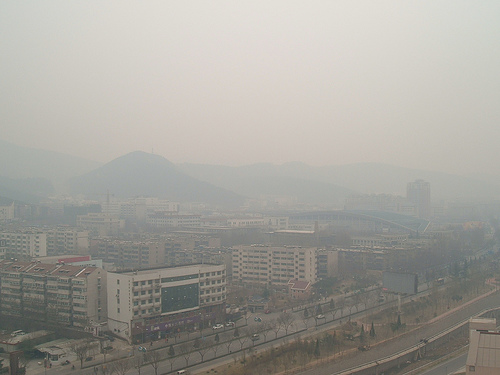Imagine you’re an airline pilot. Which of the cities below looks like the more appealing one for landing a large jet?
#Beijingair View of Tsinghua University 1/24 (“Moderate”) vs Today (PM2.5; 462.0; 475; Hazardous). twitter.com/wafarris/statu…
— William Farris (@wafarris) January 29, 2013
To the left, an image of Beijing’s air taken last week when the pollution monitor on top of the U.S. Embassy measured a fairly low level of particulate pollution (29 parts per million per volume). To the right? The air yesterday, at a level of 462. If you chose the image at left, congratulations. Airlines in Beijing agree with your assessment.
From Huffington Post:
Thick, off-the-scale smog shrouded eastern China for the second time in about two weeks Tuesday, forcing airlines to cancel flights because of poor visibility and prompting Beijing to temporarily shut factories and curtail fleets of government cars. …
The U.S. Embassy reported an hourly peak level of PM2.5 — tiny particulate matter that can penetrate deep into the lungs — at 526 micrograms per cubic meter, or “beyond index,” and more than 20 times higher than World Health Organization safety levels over a 24-hour period. …
Visibility was less than 100 meters (100 yards) in some areas of eastern China, the official Xinhua News Agency reported. More than 100 flights were canceled in the eastern city of Zhengzhou, 33 in Beijing, 20 in Qingdao and 13 in Jinan.
The severe pollution has been a problem on and off for weeks. We first wrote about it two weeks ago yesterday, noting that the city was enacting restrictions on factory emissions and driving in an effort to curb the problem. But we also noted that the problem isn’t Beijing’s alone; much of the soot and haze is created in nearby cities and the countryside, drifting into the capital and settling over the city. It’s a regional problem.
With acute repercussions. Again from the Associated Press:
Patients seeking treatment for respiratory ailments rose by about 30 percent over the past month at the Jiangong Hospital in downtown Beijing, Emergency Department chief Cui Qifeng said.
“People tend to catch colds or suffer from lung infections during the days with heavily polluted air,” he said.
CNN notes that 9,000 children visited a Beijing pediatric hospital with respiratory problems this month. These effects are immediately demonstrable. More insidious? A recent study suggested that soot pollution results in more than 3.2 million deaths a year globally.
In a few days, the problem will recede. (It hasn’t yet; as I write this levels are still listed as “hazardous.”) The question then becomes how urgent the problem remains for Chinese leaders — and for how long Beijing residents will feel the health effects.



